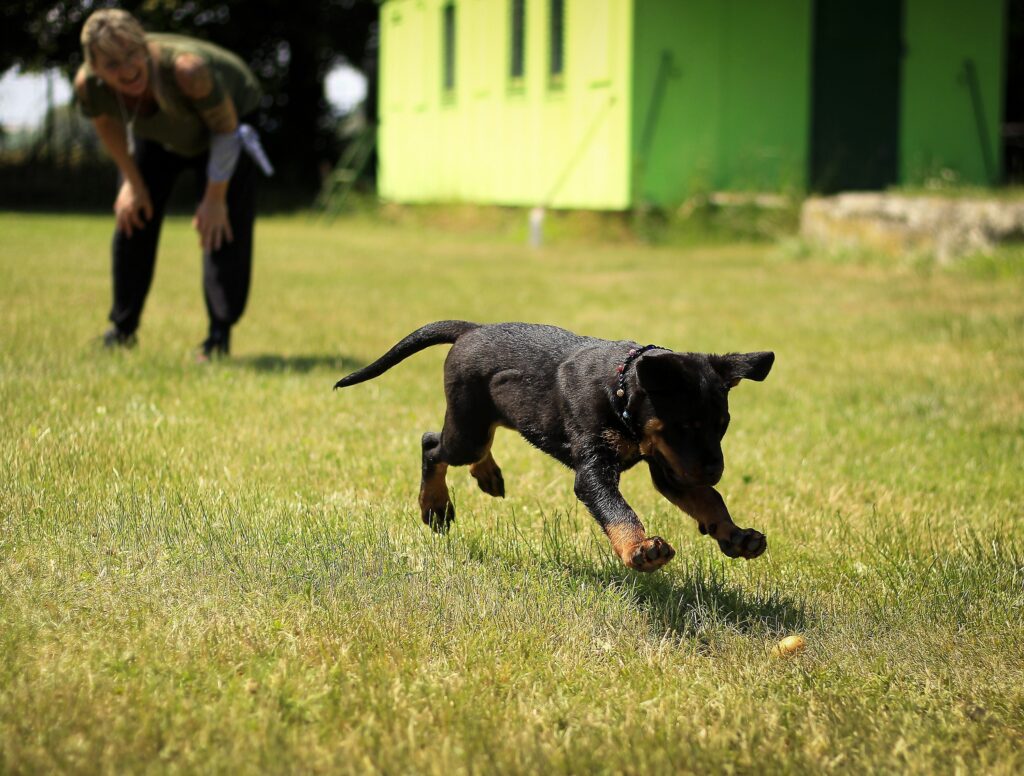How to teach a dog to fetch? Is a question we always hear. Fetch is a classic, fun game that provides an excellent opportunity for bonding and exercise for both you and your canine companion. But teaching your dog to fetch can seem like a daunting task, especially if you’re a first-time dog owner.
Fear not! With a little patience, creativity, and some tried-and-true techniques, you’ll have your dog fetching in no time.
This article will cover the basics of the game, effective training methods, and tips to make fetch a rewarding experience for both you and your furry friend.
Table of Contents
Understand the Basics of Fetch
Before you begin teaching your dog to fetch, it’s essential to understand the basic components of the game. At its core, fetch consists of three key elements:

- The throw: Tossing an object (usually a ball, stick, or toy) for your dog to chase.
- The retrieve: Your dog chasing the thrown object, picking it up, and returning to you.
- The release: Your dog willingly dropping the object so you can throw it again.
The key to teaching your dog to fetch is to break down the game into these smaller components and train them individually. Once your dog masters each step, you’ll combine them to create the full fetch experience.
Choose the Right Fetch Toy
To set your dog up for success, you need to pick a fetch toy that is appropriate for their size, breed, and preference. The right toy will motivate your dog to engage in the game and help them learn faster. Some popular fetch toys include:
- Tennis balls: A classic choice suitable for many dogs, but avoid using them with strong chewers, as they can destroy the ball and ingest the pieces.
- Rubber balls: Durable and bouncy, they’re perfect for dogs who love to chew and can also float on water for dogs who enjoy swimming.
- Frisbees: Flat, lightweight, and easy to throw, they’re ideal for dogs that enjoy chasing flying objects.
- Stuffed toys: Soft and cuddly, these toys are great for gentle-mouthed dogs who prefer carrying their prizes gently.
Experiment with a variety of toys to see which one your dog enjoys the most, but remember to always prioritize safety.
Create a Positive Association with the Fetch Toy
Before you start training, it’s crucial to create a positive association with the chosen fetch toy. To do this:
- Play with the toy together: Encourage your dog to interact with the toy by playing a game of tug or simply allowing them to chew on it.
- Use treats: Hold the toy in one hand and a treat in the other. Let your dog sniff the toy, and when they show interest, reward them with the treat.
- Incorporate the toy into daily activities: Keep the fetch toy nearby during walks, playtime, and even mealtime to reinforce its importance and desirability.
Teach Your Dog to Chase the Toy
Now that your dog has a positive association with the toy, it’s time to teach them to chase it:
- Start in a distraction-free environment, like your backyard or a quiet park.
- Engage your dog’s interest by waving the toy around and making exciting noises.
- Gently toss the toy a short distance away from your dog, making sure they see it.
- When your dog chases after the toy, praise them enthusiastically and reward them with a treat.
- Repeat this process until your dog consistently chases the toy when thrown.
Teach Your Dog to Retrieve the Toy
Once your dog is chasing the toy, it’s time to teach them to pick it up and bring it back:
- When your dog reaches the toy, encourage them to pick it up by using a cue like “get it” or “fetch.”
- As soon as your dog picks up the toy, call them back to you using their name, a recall command like “come” or “here,” or by patting your legs and excitedly saying “yes” or “good.”
- If your dog doesn’t return with the toy, try running away from them in the opposite direction. Most dogs will instinctively chase after you, toy in tow.
- When your dog approaches you with the toy, praise them lavishly and reward them with a treat or a brief game of tug as a play-based reward.
Repeat these steps, gradually increasing the distance you throw the toy. Make sure to keep training sessions short and enjoyable to maintain your dog’s enthusiasm.
Teach Your Dog to Release the Toy
The final component of fetch is teaching your dog to willingly drop the toy once they’ve brought it back to you. To do this:
- Have a treat or a second toy ready when your dog returns with the fetched object.
- Hold the treat or second toy close to your dog’s nose, and use a release command like “drop it” or “give.”
- Once your dog drops the fetched object, immediately reward them with the treat or second toy.
- Practice this exchange several times, eventually phasing out the treat or second toy as your dog becomes more proficient with the command.
Remember to be patient and consistent. It may take some time for your dog to grasp the concept of releasing the toy on command.
Combine the Steps to Play Fetch
Now that your dog has mastered each component of fetch, it’s time to combine them into a seamless game:
- Throw the toy and encourage your dog to chase it using the cues they’ve learned.
- When your dog picks up the toy, call them back to you and praise them for returning.
- Once your dog is back, use the release command to have them drop the toy.
- Reward your dog with praise, treats, or a brief game of tug before repeating the process.
Tips for Successful Fetch Training
Patience is key: Learning fetch can be challenging for some dogs, so be patient and maintain a positive attitude.
Keep sessions short and fun: Limit training sessions to 10-15 minutes, and always end on a high note to keep your dog excited about the game.
Use high-value rewards: Reserve your dog’s favorite treats or toys for fetch training to keep them motivated.
Gradually increase difficulty: Start with short, easy throws and slowly progress to longer distances and more challenging environments.
In Closing
Teaching your dog to fetch can be a rewarding and enjoyable experience for both of you.
With patience, consistency, and a touch of creativity, you’ll soon have a fetching pro on your hands. Remember to always prioritize safety and choose the right toy for your dog.
Most importantly, have fun and cherish the bonding moments that fetch provides. Happy fetching!
You may also be interested in, “How to teach a dog to shake hands“?


Dennis and Becca, have always shared a passion for man’s best friend. As dog enthusiasts, they put together articles that inform, engage, and captivate fellow dog lovers.